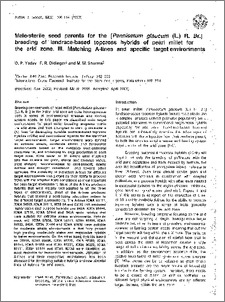Male-sterile seed parents for the breeding of landrace-based topcross hybrids of pearl millet for the arid zone. III. Matching A-lines and specific target environments
Abstract
The main target environments for pearl millet breeding programmes within the Indian arid zone, and male-sterile (A) lines for the development of suitable landrace-based topcross hybrids (TCHs) and conventional hybrids for the target environments were identified. The target environments were defined as extreme stress, moderate stress and favourable environments based on the available environmental resources for crop production in each target zone. TCHs based on 39 A-lines were classified into five clusters for grain, stover and biomass yields, yield stability, responsiveness to environment, downy mildew (Sclerospora graminicola) and drought resistance, and other variables. The suitability of individual A-lines for different target environments was evaluated based on their ability to produce TCHs with the adaptive traits considered as most important for each target environment. None of the A-lines produced hybrids that were equally well-adapted to all the three types of environments; most of the A-lines produced hybrids that showed a contrasting adaptation pattern to the different target environments. The A-lines ICMA 93111, ICMA 94555, ICMA 95111, HMS 9A and CZMS 44A produced highly stable dual purpose hybrids, whereas 842A, ICMA 95444, ICMA 97111, ICMA 97444 and 843A produced grain hybrids that were suitable for extreme stress environments. Hybrids developed with ICMA 97333, ICMA 93111, ICMA 95555, ICMA 96333, 842A, ICMA 91444 and ICMA 92666 were suitable for moderate stress environments since these hybrids were high-yielding, moderately stable and responsive hybrids to better environments. Hybrids based on 5054A, ICMA 88006, ICMA 95222, ICMA 92333, ICMA 92444, ICMA 94555, ICMA 97333, ICMA 96222, ICMA 97111, ICMA 91444 and ICMA 95444 were the most desirable for favourable environments

